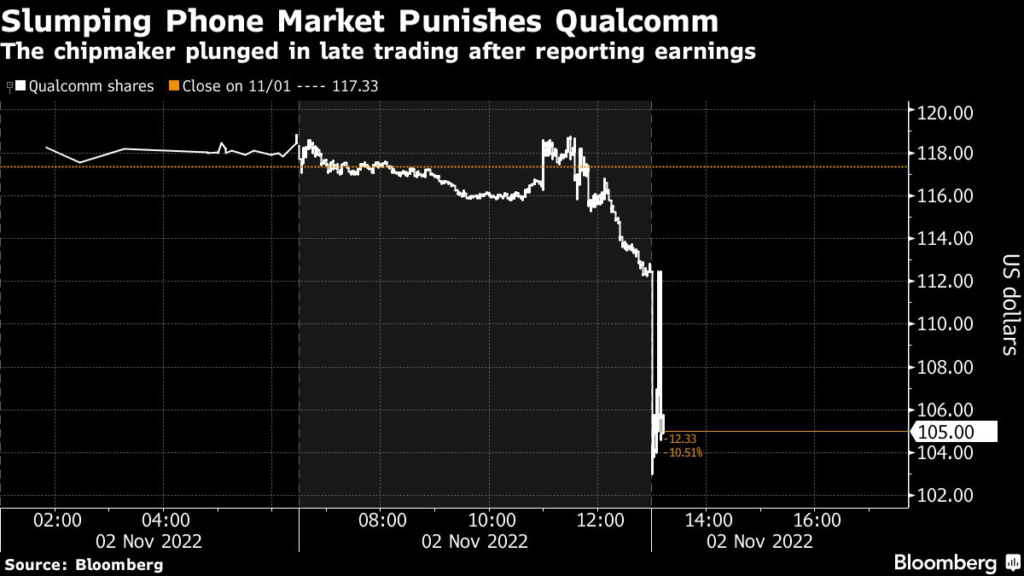Qualcomm Inc., the biggest maker of smartphone processors, tumbled in pre-market trading after giving a far weaker forecast than expected, punished by the economic slowdown and Covid-19 lockdowns in China.
(Bloomberg) — Qualcomm Inc., the biggest maker of smartphone processors, tumbled in pre-market trading after giving a far weaker forecast than expected, punished by the economic slowdown and Covid-19 lockdowns in China.
Revenue will be $9.2 billion to $10 billion in the fiscal first quarter, Qualcomm said Wednesday. That compares with an average analyst estimate of $12 billion. Excluding certain items, earnings will be $2.45 a share at best, Qualcomm said. The average projection was $3.40.
Qualcomm is coping with the slowdown in part by freezing hiring, executives said during a conference call. The buildup of extra inventory may take two quarters to clear, the company said.
Qualcomm Slips on China, Android Demand Weakness: Street Wrap
The outlook showed that the market for consumer devices is eroding faster than feared, sending Qualcomm shares plunging as much as 7.2% in pre-market trading on Thursday. Even before the report, the stock was down 38% this year, hurt by concerns that smartphone demand was on shaky ground.
“The further deterioration of the macroeconomic environment and sustained Covid restrictions in China have led to broad-based demand weakening across tiers and regions,” the San Diego-based company said in a presentation to investors.
Chief Executive Officer Cristiano Amon has said that his tenure will be defined by how successful he is in pushing the chipmaker’s technology into new areas, including automotive equipment, networking and computers. While Qualcomm is getting more revenue from those newer efforts, the bulk of its sales still comes from phones, limiting the company’s overall growth.
Qualcomm’s main product is the processor that runs many of the world’s smartphones. It also sells the modem chips that connect Apple Inc.’s iPhone to high-speed data networks.
Three months ago, Qualcomm slashed its projection for smartphone shipments, predicting a decline in the mid-single-digit percentage range in 2022 from the prior year. Phone makers have been working through excess inventory before they return to ordering.
Now the picture is even more bleak. The phone market will contract in the low-double-digit percent range, and excess inventory will continue to be a drag on orders throughout the fiscal first quarter, Qualcomm said.
There is one silver lining, though. The company had expected Apple to start replacing most of Qualcomm’s 5G modems in the iPhone next year with homegrown parts. That’s no longer expected to happen in 2023.
Apple has weathered the smartphone slowdown better than many companies in the industry, but it too saw some softness last quarter. The iPhone, Apple’s flagship device, generated about $42.6 billion in the period, slightly less than analysts had projected.
Overall, Apple delivered strong results, bucking the trend of weak technology earnings this season. But the specter of higher interest rates has loomed over the company. Apple and Microsoft Corp. led tech stocks lower Wednesday after Federal Reserve Chair Jerome Powell suggested it was too early to think about pausing rate hikes.
Apple also has suffered from Covid disruptions in China, including the lockdown of a Foxconn Technology Group complex in Zhengzhou this week.
At Qualcomm, fiscal fourth-quarter revenue was $11.4 billion, in line with estimates. Profit in the period, which ended Sept. 25, was $3.13 a share, excluding some items. That also matched projections.
In addition to selling smartphone chips, Qualcomm licenses the fundamental technology that underpins modern phone networks. And even phone makers that don’t rely on its chips pay to use its intellectual property.
“While our financial outlook has been temporarily impacted by elevated channel inventory, our diversification strategy and long-term opportunities remain unchanged,” Amon said in a prepared statement.
(Updates with hiring freeze in third paragraph.)
More stories like this are available on bloomberg.com
©2022 Bloomberg L.P.











